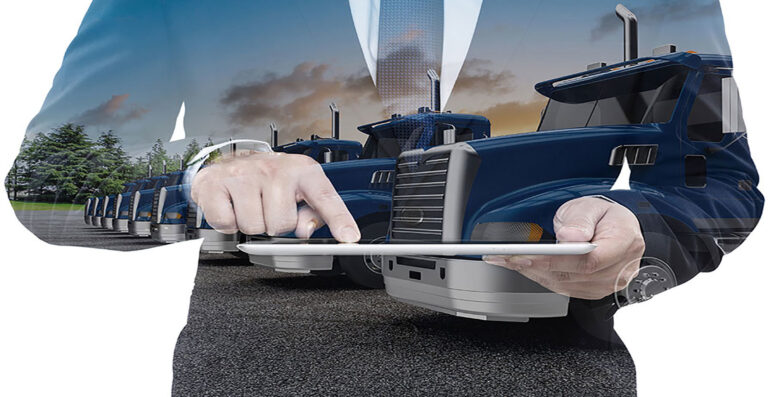7 Tools Every Fleet Manager Needs in 2020
The first fleet manager was probably a mead-drinking medieval burgher. His nicest shirt was chain mail and he loaded shipments onto carts and wagons. For this forefather of fleets, cutting edge technology management meant adding fancy new mechanical clocks to his office. The invention of eyeglasses would have been even more exciting – now, his half-blind drivers wouldn’t accidentally drive their horses off the road!
Every era has its innovators. Today, clocks and glasses are taken for granted – but that medieval fleet manager’s smartest descendants are just as interested in new technologies as he was. 2020, the dawn of a new decade, is the perfect year to add these state-of-the-art tools to your fleet:
1: 360° DashCams
A decade ago, most transportation professionals wouldn’t have known what the term “nuclear verdict” meant. Today, the words send shivers down fleet managers’ spines.
If you’re lucky enough to be unfamiliar with the term, a “nuclear verdict” is when a jury awards upward of ten million dollars to a lawsuit’s plaintiffs. While the average crash still costs employers far less than that – $16,500 if there’s no injury, $74,000 if there is – juries have started to award multi-million dollar settlements far more often than they used to. Since 2011, at least fifty verdicts have forced carriers to fork out ten million dollars or more.
Unfortunately, today’s juries tend to distrust the trucking industry. Take the example of a May 2018 verdict against Werner Enterprises: In 2014, a woman driving westbound on Texas’ Interstate 20 lost control of her car, drove across the grassy median, and ran into the eastbound lanes. A Werner driver hit her and she sued. The jury found Werner at fault, awarding the woman a $10 million verdict.
That’s why putting a dashcam in every cab should be your fleet’s top priority. In worst-case scenarios, it can be the only thing that will make a jury believe that your driver is 100% not at fault.
The best dashcams livestream everything and keep recordings of the moments before and after crashes happen. They record on physical SD cards and send digital recordings to the cloud. Outfitted with night vision, they illuminate low-light recordings. Only one dashcam does all of this and records every single centimeter of the cab and the road – the AI Dashcam.
2: Fuel Waste Reduction Tools
Not all carriers are burdened with huge legal bills – but absolutely every carrier is burdened with huge fuel bills. According to the US Department of Energy, “Typically, a long haul truck idles about 1,800 hours per year, using about 1,500 gallons of diesel.”
While most drivers should idle less, some are worse offenders than others. In the average fleet, 20% of drivers contribute to 80% of fuel waste.
Solutions like FleetUp’s Fuel Waste Analysis fight the problem from several directions at once. Automatically generated reports show you which drivers and which vehicles are using the most gas. With individual drivers, you’ll see a chart which breaks down each of their fuel wasting behaviors (speeding, idling, etc.) by percentage, so you can show them exactly how they can improve.
Fuel costs have eaten up profits since the era of the Model T – but today, you can reduce your fleet’s gas usage to the barest possible minimum. There’s no more effective way to cut costs and boost revenue.
3: Engine Maintenance Tools
You already know how important it is to hire smart and experienced mechanics. But even if you’ve got the world’s hardest-working garage, there’s no way that your team can identify an engine issue if it pops up while the vehicle is hundreds of miles away.
That’s why engine maintenance tools are an absolute must-have. They’re the equivalent of hiring a mechanic to live under your vehicles’ hoods, checking and re-checking engine health throughout every mile of every drive.
Real-Time Engine Diagnostic solutions monitor engine temperature and battery level. The best also regularly send Diagnostic Trouble Code (DTC) data, so mechanics can cheaply fix small issues before they explode into catastrophic problems. Because these solutions are always tracking engine health, they’ll notify you of a problem even if a vehicle is on the opposite coast.
If you want to enhance the effectiveness of your Real-Time Engine Diagnostics solution, Vehicle E-Maintenance Scheduling is a complementary addition to your carrier’s tool set. It streamlines communication between your drivers, office staff, and mechanics by automating maintenance log management. There’s no other error-free method of tracking how often oil, tires, spark plugs, air filters, and more are changed. The most cutting-edge maintenance scheduling tools let you set your own parameters, so you, not some one-size-fits-all algorithm, decide how often your vehicles come to the shop.
4. Driver Management Tools
While managing vehicles is one of a fleet manager’s primary jobs, it’s not hard to guess that most of your work hours aren’t devoted to dealing with mechanical issues. At the end of the day, the majority of a fleet manager’s time is spent managing people, not engines. That’s why a powerful suite of driver management tools can have a huge impact on your fleet.
When we discussed dashcams, we saw how lawsuits can financially bury carriers. While dashcams are a great way to guard against lawsuits, they’re not the only way. When Driver Safety Scorecards are used in tandem with dashcams, they significantly reduce your carrier’s risk of being found at fault in crashes. Driver Safety Scorecards show you exactly how often each of your drivers engage in risky behaviors like speeding, sharp turing, and harsh braking. With that information, you can reward your safest drivers and give your riskiest drivers the training they need – before they do something they regret.
Fortunately, most of your day-to-day work probably has nothing to do with accidents and crashes. The far more humdrum tasks that take up a large chunk of most fleet managers’ time involves paperwork, payroll, and record-keeping. It’s stuff that has to be done – but it’s not exactly multiplying your fleet’s profitability. That’s why so many fleet managers have taken advantage of Workforce Management solutions. These tools automate record keeping and payroll reports. The best also analyze driver availability, monitor how many hours vehicles have been in use, and help you minimize driver and vehicle downtime.
5. Communication Tools
Back in the ‘80s, drivers had to stop and find a payphone if they wanted to talk to you. Today? They can make a phone call from the cab, shoot you a text, write an email, start a video call, and even hit you up on social media.
While no one would argue that smartphones have made communication more difficult, the proliferation of communication options has made it easier for important messages to get lost in the shuffle. Maybe you accidentally sent a text to a driver who only trusts phone calls, or left a voice message with a driver who never checks his voice message box. When these all-too-common mix-ups occur, pick-ups get missed, shipments get delivered late, and clients get upset.
The best fleet managers cut through the noise by streamlining their communications with an all-in-one app. These solutions give you everything you need to assign tasks to staff, communicate with on-the-road drivers, and make sure everyone from your mechanic to your accountant can easily see and send the documents they need. When a driver in California wants to send a message to your payroll staffer in New York, a photo to your mechanic in Arkansas, and a DVIR to the FMCSA, an all-in-one app helps them do it all without having to log in and out of umpteen different accounts.
6. Trip Sharing Tools
Cutting-edge technology will help you tame your vehicles and your staff. What’s more surprising is that it can also help you manage the fussiest, most exasperating beast of them all – your customers!
In the era of Amazon, carriers face two problems: Customers want a huge amount of information about their shipments, while their loading docks are busier than ever. Both of those issues put an immense amount of pressure on drivers and fleet managers. One tool helps reduce that pressure: Trip Sharing.
Trip sharing tools allow you to send customers alerts about exactly where their shipments are and when they’ll arrive. These features provide the Amazon-level service that many people have come to expect. The most well-designed trip sharing tools also help customers plan their loading schedules more efficiently, so your drivers don’t waste countless hours waiting at their docks. This helps you manage the wait times that keep your drivers off the road.
Trip sharing tools help you build trust, develop positive client relationships, and reduce loading dock inefficiencies. You already expertly manage your staff – now you can expertly manage your customers, too.
7. Theft Protection Tools
As a fleet manager, your most valuable property isn’t safely inside your office – it’s in parking spots, alleys, truck stops, and not-so-carefully guarded loading docks all over the country. The fact that vehicles and shipments are uniquely vulnerable is one of those transportation industry headaches that’s just an everyday part of your job – and it’s only becoming more of a migraine. According to a report from SensiGuard, reported cargo thefts in the US rose 25% in the first quarter of 2019. The average loss rose 1% to $116,717.
Fortunately, there are a few tools that help prevent theft and help recover stolen property. The first we’ve already mentioned – the dashcam. FleetUp’s AI Dashcam saves all recordings of break-ins on a micro SD card and in the cloud. Even if all a thief steals is your driver’s wallet, you’ll have a recording that will help police find the perpetrator.
In worst-case scenarios, both vehicles and valuable shipments can disappear into thin air. A simple tool will prevent that from ever happening – the Discreet Asset Tracker. These small, portable devices are easy to throw into a pallet or tuck into a hidden nook. If a thief steals a vehicle outfitted with a Discreet Asset Tracker, they won’t get very far before they’re found.
From Donkey Carts to the Model T to Autonomous Vehicles and Beyond!
When the clock hits midnight on December 31s, 2019, raise a mug of mead (or champagne, whatever’s closer!) to our bold forefather, the wagon-loading medieval burgher. As we hit the gas pedal and drive into the next decade, let’s bring his innovative spirit along for the ride. Here’s to fleet managers past, present, and future!






